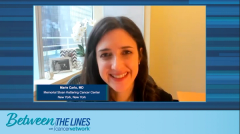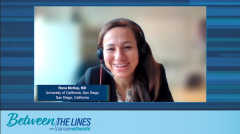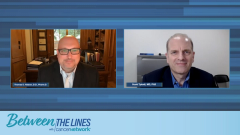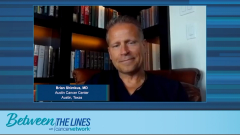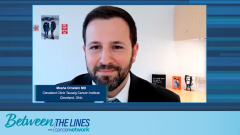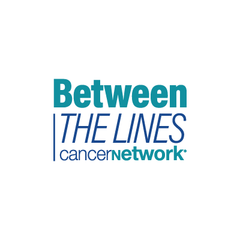
Lenvatinib + Pembrolizumab or Everolimus for Advanced Renal Cell Carcinoma: Key Takeaways
Rana McKay, MD, and Tom Powles, MBBS, MRCP, MD, highlight key data from the CLEAR trial and offer their overall opinions on the combination of lenvatinib plus pembrolizumab for the treatment of renal cell carcinoma [RCC].
Episodes in this series

Rana McKay, MD: We're all about CLEAR today and talking about the CLEAR data of lenvatinib and pembrolizumab in first line RCC. Tom, what do you think are your takeaways from the 2021 New England Journal Publication?
Tom Powles, MBBS, MRCP, MD: I was impressed with 2 things. Firstly, I'm impressed with the consistency of the survival signal for the VEGF TKI [tyrosine kinase inhibitor] PDI combinations. And that's axitinib and pembrolizumab, cabozantinib and nivolumab. And now lenvatinib, pembrolizumab, and they all show a 30% reduction in the risk of death associated with the combination. And that's super cool. And that consistency, for me does drive the preference to move away from sunitinib completely or crizotinib completely and say that's no longer the standard of care. It's now PDI based therapy. Obviously, this is a base about VEGF TKI vs CTLA4. That was the first part that I liked. And then the second part that I liked as well was I thought the lenvatinib, pembrolizumab data had 1 or 2 data points that were exceptional. I thought the hazard ratio of 0.39 for PFS [progression free survival] was unusually low. And I thought that was impressive. And I thought the response rate above 70% was high. And I thought that was also impressive. For me that was the take home message from that combination. What about you what were your thoughts rather?
Rana McKay, MD: No, I completely agree. It's good to see data that's consistent across the board. And that consistency that now the new standard of care is I/O [immuno-oncology] combinations and frontline is the new standard for RCC frontline. It's hard to compare all of these trials, because the patients that were enrolled were slightly different, the percentage of patients who were favorable or intermediate poor was slightly different whether they had an effect to me was slightly different. So it's hard to compare that data. But I have to say that the PFS of almost 2 years, with a hazard ratio there as you pointed out of 0.39 is impressive. The big question in everybody's mind is, is there going to be a sustainability and durability of that PFS as we continue to monitor these patients over time? And will we start to see the curves plateau? But it's incredibly impressive that median time before somebody were to progress is 2 years. That's exciting. And I do agree with you, the response rates are, again, impressive when we think about all the data that we've seen thus far, 71%, hard to know how to interpret the complete response data 16%. Getting a sense of the burden of disease of these patients coming on and what was their volume of disease, as we interpret that complete response data. And quite honestly, are the PFS and the complete responses durable? And that's the most important thing as we think about things, but it's clearly a highly effective regimen in the landscape for RCC.
Transcript edited for clarity.
Newsletter
Stay up to date on recent advances in the multidisciplinary approach to cancer.


